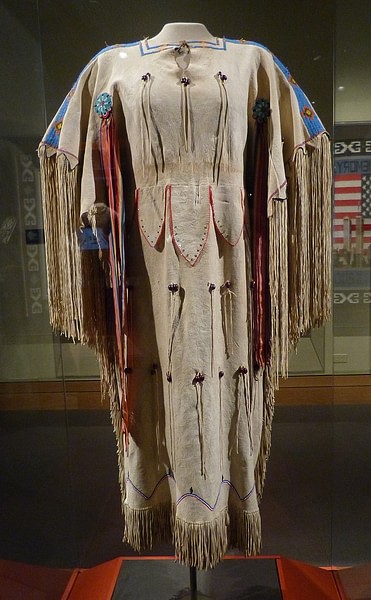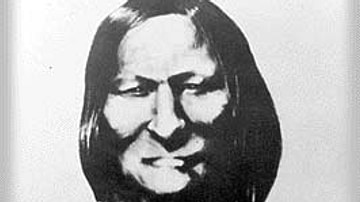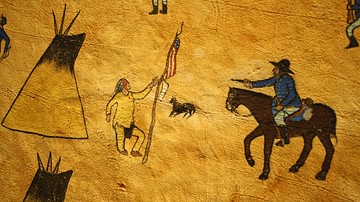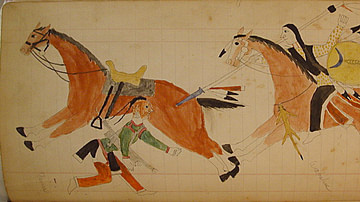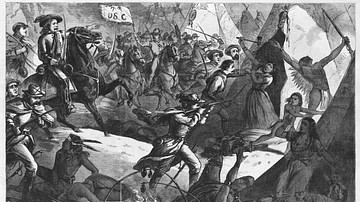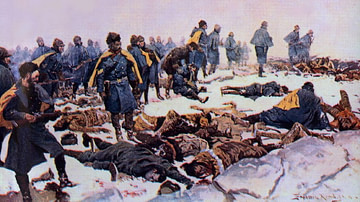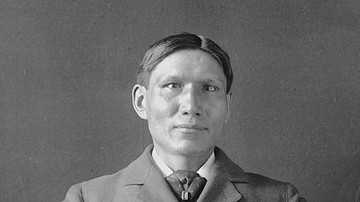The earliest reports on the Sand Creek Massacre (29 November 1864) characterized it as a great battle in which the Third Colorado Cavalry under Colonel John Chivington defeated a large force of armed Cheyenne and Arapaho warriors. By the end of December 1864, that version of the event had been challenged.

Colonel John Chivington (l. 1821-1894) had actually led his men against a village of Cheyenne and Arapaho in full compliance with the policies of Governor John Evans (l. 1814-1897) who had offered safety to peaceful tribes, friendly toward the US government, who might, therefore, fall prey to the hostile bands that were raiding wagon trains and settlements in the Colorado region. Black Kettle (l. c. 1803-1868), chief of the Southern Cheyenne, and Chief Niwot (also known as Left Hand, l. c. 1825-1864) of the Southern Arapaho led their people to Sand Creek as directed by Evans. Most had surrendered their weapons at Fort Lyon and the village was primarily occupied by women, children, and the elderly.
The event described as a "battle" was therefore a massacre of mostly unarmed Natives who, further, were flying both the American flag and the white flag of truce, as they had been told to do by Evans to identify themselves as "friendlies" and ensure their safety from the very troops that wound up slaughtering most of them.
Shortly after the massacre, Chivington sent his superior, General Samuel Curtis, a report claiming to have defeated a force of heavily armed Cheyenne and Arapaho warriors "from 900 to 1,000 strong" who had fortified the village and were deeply dug in (Kelman, 9). He then sent a similar account to the local papers in Denver – including the Rocky Mountain News – establishing the conflict as a "battle" and his opponents as hostiles.
This version of the event was then reported by other newspapers at the time and continued to be accepted as truth even after eyewitness accounts of the events of 29 November 1864 completely contradicted it. Even today, the Sand Creek Massacre is sometimes referenced as a "battle" when, in fact, it was a surprise attack and slaughter of mostly unarmed people who had every reason to believe the government forces approaching their camp would protect them.
Media Coverage of Sand Creek
The first reports were taken from Chivington's account, which was supported by Major Scott Anthony, commander of the garrison at Fort Lyon. The report of the Rocky Mountain News on 17 December 1864 (given in full below) gives an account of the event which by the end of the month and into January 1865 would prove to be largely fiction. The testimony of eyewitnesses – notably Captain Silas Soule (l. 1838-1865) who was present but did not participate in the massacre – challenged Chivington's version of events, resulting in a formal investigation of the incident by Congress and the War Department, but, still, many preferred to believe the initial report of a "battle", and, as noted, some still do today.
Eyewitness testimony presents a completely different picture, however, and some of these accounts are given by men who participated in the massacre. Major Anthony, for example, relates this incident:
There was one little child, probably three years old, just big enough to walk through the sand. The Indians had gone ahead, and this little child was behind, following after them. The little fellow was perfectly naked, traveling in the sand. I saw one man get off his horse at a distance of about seventy-five yards and draw up his rifle and fire. He missed the child. Another man came up and said "let me try the son of a b-. I can hit him." He got down off his horse, kneeled down, and fired at the little child but he missed him. A third man came up and made a similar remark, and fired, and the little fellow dropped.
(Vasicek, 2)
Silas Soule, in his account, gives Anthony's own conduct during the massacre:
Hundreds of women and children were coming towards us, getting on their knees for mercy. Major Anthony responded by shouting "Kill the sons of bitches."
(Kelman, 23)
A witness whose name was not recorded supports the accounts of many others that those killed were mostly women, children, and the elderly. White Antelope (l. c. 1789-1864), another Cheyenne peace chief like Black Kettle, was in his seventies when he was murdered at Sand Creek, as were many other elder chieftains of both the Cheyenne and Arapaho. Most of those massacred, however, were women and children.
I saw five squaws under a bank for shelter. When the troops came up to them, they ran out and showed their persons to let the soldiers know they were squaws and begged for mercy, but the soldiers shot them all…There were some thirty or forty squaws collected in a hole for protection; they sent out a little girl about six years old with a white flag on a stick. She had not proceeded but a few steps when she was shot and killed. Everyone I saw dead was scalped…I saw the body of White Antelope with the privates cut off and I heard a soldier say he was going to make a tobacco pouch out of them…I saw quite a number of infants in arms killed with their mothers.
(Vasicek, 2)
These accounts were already known by the end of December 1864 but were rejected as "tales" conjured up by "folks back east" who were sympathetic to the Native American cause. No one wanted to believe that US troops had murdered unarmed men, women, and children, and so, if anything, the eyewitness reports only made Chivington's version of the event more popular and firmly established because these accounts were too horrible to be accepted. The second piece from the Rocky Mountain News, published 30 December 1864 (given below in part), rejects any claims of a massacre and supports Chivington's version of the event as a battle.
Text
The following are taken from the site The Sand Creek Massacre: Editorials from the Rocky Mountain News After the Attack, compiled by Kevin Cahill, reprinted with permission.
Rocky Mountain News, December 17, 1864
THE BATTLE OF SAND CREEK.
Among the brilliant feats of arms in Indian warfare, the recent campaign of our Colorado volunteers will stand in history with few rivals, and none to exceed it in final results. We are not prepared to write its history, which can only be done by someone who accompanied the expedition, but we have gathered from those who participated in it, and from others who were in that part of the country, some facts which will doubtless interest many of our readers.The people of Colorado are well aware of the situation occupied by the third regiment during the great snow-storm which set in the last of October. Their rendezvous was in Bijou Basin, about eighty miles southeast of this city, and close up under the foot of the Divide. That point had been selected as the base for an Indian campaign. Many of the companies reached it after the storm set in marching for days through the driving, blinding clouds of snow and deep drifts. Once there, they were exposed for weeks to an Arctic climate, surrounded by a treeless plain covered three feet deep with snow. Their animals suffered for food and with cold, and the men fared but little better. They were insufficiently supplied with tents and blankets, and their sufferings were intense. At the end of a month the snow had settled to the depth of two feet, and the command set out upon its long-contemplated march. The rear guard left the Basin on the 23d of November. Their course was southeast, crossing the Divide and thence heading for Fort Lyon. For one hundred miles the snow was quite two feet in depth, and for the next hundred it ranged from six to twelve inches. Beyond that the ground was almost bare and the snow no longer impeded their march.
On the afternoon of the 28th the entire command reached Fort Lyon, a distance of two hundred and sixty miles, in less than six days, and so quietly and expeditiously had the march been made that the command at the fort was taken entirely by surprise. When the vanguard appeared in sight it was reported that a body of Indians were approaching, and precautions were taken for their reception. No one upon the route was permitted to go in advance of the column, and persons who it was suspected would spread the news of the advance were kept under surveillance until all danger from that source was past.
At Fort Lyon the force was strengthened by about two hundred and fifty men of the first regiment, and at nine o'clock in the evening the command set out for the Indian village. The course was due north, and their guide was the Polar star. As daylight dawned, they came in sight of the Indian camp, after a forced midnight march of forty-two miles, in eight hours, across the rough, unbroken plain. But little time was required for preparation. The forces had been divided and arranged for battle on the march, and, just as the sun rose, they dashed upon the enemy with yells that would put a Comanche army to blush. Although utterly surprised, the savages were not unprepared, and for a time their defense told terribly against our ranks. Their main force rallied and formed in line of battle on the bluffs beyond the creek, where they were protected by rudely constructed rifle-pits, from which they maintained a steady fire until the shells from company C's (third regiment) howitzers began dropping among them, when they scattered and fought each for himself in genuine Indian fashion. As the battle progressed the field of carnage widened until it extended over not less than twelve miles of territory. The Indians who could, escaped or secreted themselves, and by three o'clock in the afternoon the carnage had ceased. It was estimated that between three and four hundred of the savages got away with their lives. Of the balance there were neither wounded nor prisoners. Their strength at the beginning of the action was estimated at nine hundred.
Their village consisted of one hundred and thirty Cheyenne and eight Arapahoe lodges. These, with their contents, were totally destroyed. Among their effects were large supplies of flour, sugar, coffee, tea, &c. Women's and children's clothing were found also books and many other articles which must have been taken from captured trains or houses. One white man's scalp was found which had evidently been taken but a few days before. The chiefs fought with unparalleled bravery, falling in front of their men. One of them charged alone against a force of two or three hundred and fell pierced with balls far in advance of his braves.
Our attack was made by five battalions. The first regiment, Colonel Chivington, part of companies C, D, E, G, H and K, numbering altogether about two hundred and fifty men, was divided into two battalions the first under command of Major Anthony, and the second under Lieutenant Wilson, until the latter was disabled when the command devolved upon Lieutenant Dunn. The three battalions of the third, Colonel Shoup, were led, respectively, by Lieutenant Colonel Bowen, Major Sayr, and Captain Cree. The action was begun by the battalion of Lieutenant Wilson, who occupied the right, and by a quick and bold movement cut off the enemy from their herd of stock. From this circumstance we gained our great advantage. A few Indians secured horses, but the great majority of them had to fight or fly on foot. Major Anthony was on the left, and the third in the center.
Among the killed were all the Cheyenne chiefs, Black Kettle, White Antelope, Little Robe, Left Hand, Knock Knee, One Eye, and another, name unknown. Not a single prominent man of the tribe remains, and the tribe itself is almost annihilated. The Arapahoe probably suffered but little. It has been reported that the chief Left Hand, of that tribe, was killed, but Colonel Chivington is of the opinion that he was not. Among the stock captured were a number of government horses and mules, including the twenty or thirty stolen from the command of Lieutenant Chase at Jimmy's camp last summer.
The Indian camp was well supplied with defensive works. For half a mile along the creek there was an almost continuous chain of rifle-pits, and another similar line of works crowned the adjacent bluff. Pits had been dug at all the salient points for miles. After the battle twenty-three dead Indians were taken from one of these pits and twenty-seven from another.
Whether viewed as a march or as a battle, the exploit has few, if any, parallels. A march of 260 miles in but a fraction more than five days, with deep snow, scanty forage, and no road, is a remarkable feat, whilst the utter surprise of a large Indian village is unprecedented. In no single battle in North America, we believe, have so many Indians been slain.
It is said that a short time before the command reached the scene of battle an old squaw partially alarmed the village by reporting that a great herd of buffalo were coming. She heard the rumbling of the artillery and tramp of the moving squadrons, but her people doubted. In a little time, the doubt was dispelled, but not by buffaloes.
A thousand incidents of individual daring and the passing events of the day might be told, but space forbids. We leave the task for eyewitnesses to chronicle. All acquitted themselves well, and Colorado soldiers have again covered themselves with glory.Rocky Mountain News, December 30, 1864
THE FORT LYON AFFAIR.
The issue of yesterday's News, containing the following despatch, created considerable of a sensation in this city, particularly among the Thirdsters and others who participated in the recent campaign and the battle on Sand Creek:
WASHINGTON, December 20, 1864.
The affair at Fort Lyon, Colorado, in which Colonel Chivington destroyed a large Indian village, and all its inhabitants, is to be made the subject of congressional investigation. Letters received from high officials in Colorado say that the Indians were killed after surrendering, and that a large proportion of them were women and children.
Indignation was loudly and unequivocally expressed, and some less considerate of the boys were very persistent in their inquiries as to who those "high officials" were, with a mild intimation that they had half a mind to "go for them." This talk about "friendly Indians" and a "surrendered" village will do to "tell to marines," but to us out here it is all bosh.
The confessed murderers of the Hungate family–a man and wife and their two little babes, whose scalped and mutilated remains were seen by all our citizens–were "friendly Indians," we suppose, in the eyes of these "high officials." They fell in the Sand Creek battle.
The confessed participants in a score of other murders of peaceful settlers and inoffensive travellers upon our borders and along our roads in the past six months must have been friendly, or else the "high officials" wouldn't say so.
Conclusion
The first piece is inaccurate on several points, notably that Black Kettle was among those killed at Sand Creek and, of course, that the conflict was a battle involving hostile Cheyenne and Arapaho. The "hostiles" mentioned in both pieces were not among those encamped at Sand Creek in November 1864. Roman Nose (Cheyenne Warrior) and Chief Tall Bull of the Dog Soldiers led raiding parties on wagon trains and settlements, but the so-called "peace chiefs" like Black Kettle, White Antelope, and Chief Niwot had rejected their calls for war and consistently sought peace with the US government. The second piece is therefore inaccurate in claiming that the warriors who had participated in raids were present in the encampment at Sand Creek.

Further, Roman Nose (l. c. 1830-1868) and Tall Bull (l. 1830-1869) would have had no need to lead such raids if the US government had actually honored the promises made by the Treaty of Fort Laramie of 1851 or the Treaty of Fort Wise of 1861. The latter promised provisions and other supplies to the Cheyenne and Arapaho, which never arrived, forcing the Natives to fend for themselves just to survive.
The early controversy over whether the conflict at Sand Creek was a battle or a massacre continues today, not only in videos on the subject but also in books like I Stand by Sand Creek by William R. Dunn (arguing in defense of Chivington) and others including A Misplaced Massacre: Struggling Over the Memory of Sand Creek by Ari Kelman and Song of Sorrow: Massacre at Sand Creek by Patrick M. Mendoza, clearly presenting the event as a massacre.
This controversy seems especially baffling considering the accounts given by participants - such as Major Scott Anthony – or eyewitnesses, including Silas Soule – clearly characterizing the conflict at Sand Creek as a massacre. Although most works on the event today support this view, there are still some that continue the argument presented by the Rocky Mountain News, 30 December 1864, making claims that are as inaccurate now as they were then.

